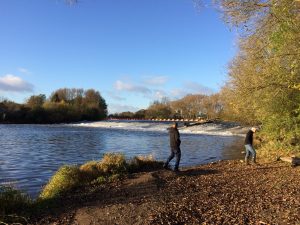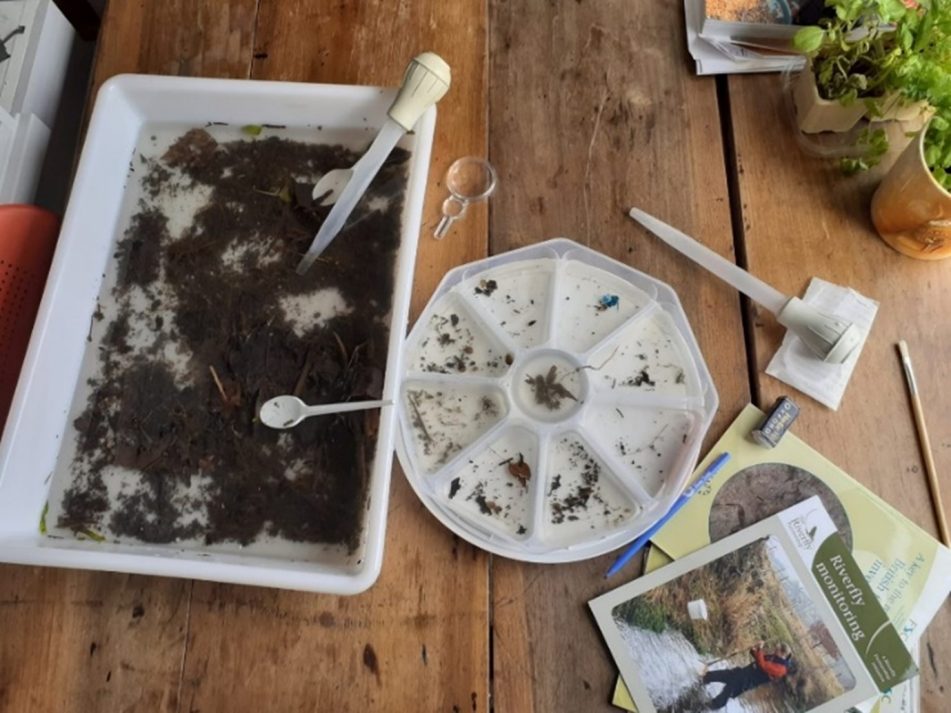
We love the ‘All About’ series, published on the Severn Rivers Trust website. These blogs have been written by Unlocking the Severn volunteers and apprentices, so we figured we’d share them here too! See the original blog on the Severn Rivers website HERE.
Written by Rachel Davies, Volunteering Officer on the Unlocking the Severn project.
Riverfly monitoring is an important way for volunteers to help us learn more about the river Severn and its tributaries. Riverfly monitoring is an exciting volunteer role that is available to everyone – no previous experience necessary! This blog tells you what riverflies are, why they are important, and how you can get involved as a riverfly volunteer.
What is a riverfly and why are they important?
The term ‘riverfly’ refers to three main groups of insects: Mayflies (Ephemeroptera), Caddiesflies (Trichoptera) and Stoneflies (Plecoptera). There are over 280 species of riverfly present in the UK. All riverflies are associated with water, as they have an aquatic larval phase. This means their eggs are laid in water, and when they hatch, the larvae live and grow in the water. Typically, they spend most of their lifecycle in this larval phase, before emerging as adult flies.
Riverflies provide three important benefits to the rivers they inhabit, they:
– Help to keep water clean by feeding on organic matter
– Form the base of many food chains
– Act as water quality indicators as they are sensitive to environmental change
Riverfly populations are affected by many factors, predominately: water quality, habitat range, water levels and water flow rates. This makes them important water quality indicators and they are often referred to as the ‘the canary of our rivers’.
Surveying Riverflies
In order to understand more about riverflies and how they relate to overall river health, we need to collect data on their distribution, and how this changes over time. Riverflies are typically surveyed during their larval stage, but can be surveyed in their adult stage too.
Surveying larvae
Larvae are usually recorded through a method called ‘kick sampling’. This involves putting a net in the water for 3-minutes and kicking the ground in front of the net to dislodge any invertebrates from the riverbed. During this 3-minute sample, the net can also be swept briefly through plants (either by the edge or in the river), helping to ensure that the different habitat types present are all surveyed.
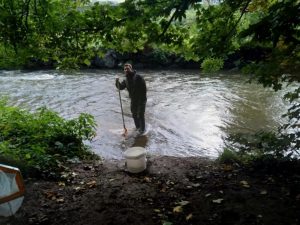
Collecting a kick sample.
This 3-minute kick sample is usually combined with 1-minute of ‘stone washing’, where several stones are borrowed from the river and washed through the net to dislodge any invertebrates clinging on. Again, this helps to ensure different habitat types are being surveyed, so a more complete picture of species present can be recorded.
Once you have your sample, it needs to be sorted so any riverflies can be picked out and identified. White trays are often used for sorting samples as it is easy to spot the riverflies on a light background. Pipettes and spoons can be used to pick up individuals so you can take a closer look at the distinguishing features.
Depending on your level of experience, you won’t always be able to identify the riverflies to species, but there are some fantastic identification guides available to help you get as far as possible. There are many different recording schemes out there. Some are aimed at complete beginners so experience in identifying riverflies can be built up gradually over time.
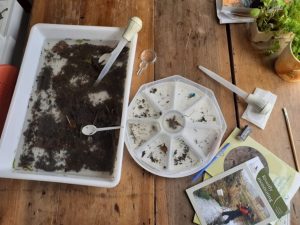
A riverfly kick sample being sorted.
Larval records collected through recording schemes are typically recorded through the Riverfly Partnership website, but casual records can go onto iRecord.
Surveying Adults
There are several methods for recording adult riverflies, with the most common being ‘sweep netting’. Sweep netting involves sweeping a special net through vegetation, catching any invertebrates resting within that vegetation, or any invertebrates that are disturbed by the net and take flight. This can also be combined with ‘beating’ vegetation. Beating involves using a stick to tap tree branches or other sturdy vegetation so that any riverflies basking on it are disturbed and take flight, making them easier to spot and catch with a net.
Another method that combines nicely here is ‘hand searching’ and this is often done along fences and on posts as riverflies like these basking spots, and can be easily potted up and identified.
Light trapping is also a popular method which works by setting up a light in a box, and leaving it outside overnight. This is a more common method for surveying moths, but some riverfly species (mainly caddisflies and stoneflies) will be attracted to the light and caught in the box, to be identified counted and released the next day.
Adult records get submitted to iRecord, where they aremanaged by the Riverfly Recording Schemes.
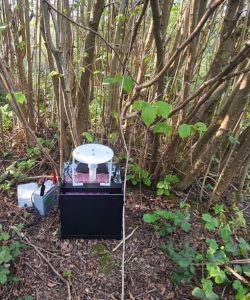
A light trap set up ready to catch riverflies.
The Riverfly Partnership
The Riverfly Partnership is hosted by the Freshwater Biological Association. It represents over 100 organisations that have come together to collect data on riverflies and water quality. The Riverfly Partnership manages several different recording schemes, enabling Citizen Scientists to get involved and help collect data on riverflies. More information on the different recording schemes can be found here on the Riverfly Partnership website.
One of the most popular recording schemes is ARMI riverfly monitoring. This is perfect for beginners, and is a really fun and rewarding volunteer role. Volunteers attend a one-day training course where they are taught everything they need to know for taking part and continuing monitoring as an independent volunteer. At the end of the day, any volunteers wishing to take on their own riverfly site will be provided with all of the equipment and information they need to get started.
Once they are trained up, volunteers select their own riverfly site (following the instructions given during the training) and are then required to visit this site once per month to collect a sample. Choosing any site to survey makes it really flexible for people with less free time, and means you can choose a river or stream of interest to you personally. It can be really interesting to see how a site changes, throughout the different seasons and over different years, and this activity is perfect for helping people notice these changes and learn more about their local rivers and streams.
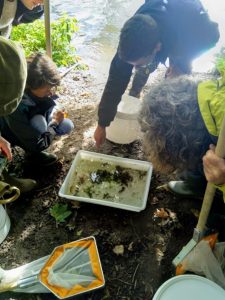
Citizen Scientists learning how to identify riverfly during one of the Severn Rivers Trust training courses
How to get involved
There are a number of ways you can get involved in riverfly surveying. If you would like to become a Citizen Scientist for the Riverfly Partnership, you can attend an ARMI training course and learn how to sample the larval stages of these incredible insects.
If you are local to the river Severn, you can do this by registering your interest in riverfly training here on our website.
If you are not local to the river Severn, you can go to the Riverfly Partnership website and use the ‘Contact Us’ form to find your local hub co-ordinator.


